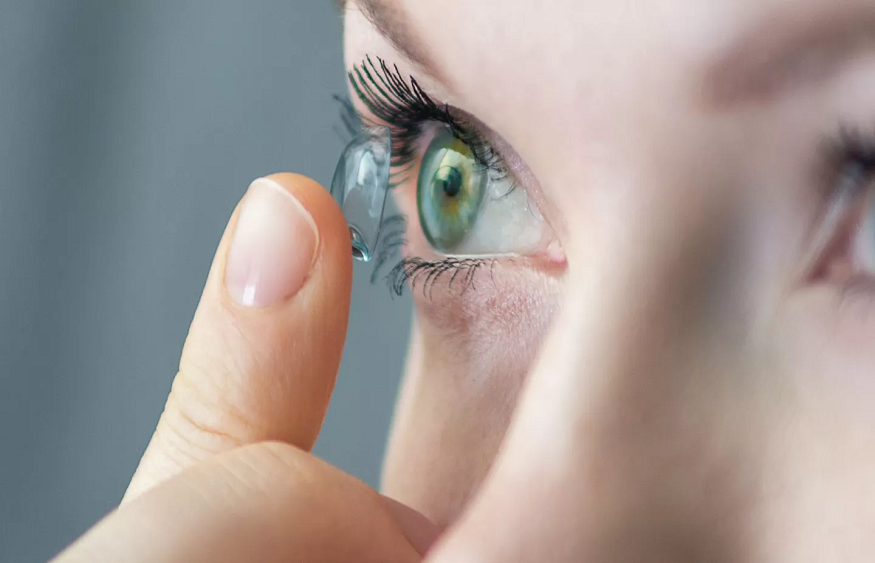Corrective lenses:
Wearers generally need to remove their lenses every night or every other day, depending on the brand and type of lenses. Some “Night & Day” lenses can be worn without interruptions, they are designed to be able to sleep with them.
For people with certain color deficiencies , a red-tint “X-Chrom” contact lens can be used. Although the lens does not restore visionperfect colors, it allows some color blind individuals to better distinguish them.
ChromaGen lenses were used and these were found to have limitations on night vision while otherwise producing significant improvements in color vision. Indeed, a previous study showed very significant improvements in color vision .
These lenses can also sometimes correct vision .
There are many colors of contact lenses. Indeed, all possible colors are adaptable to the lenses (blue, green, red, yellow, orange, etc.).
For example, some lenses may give the iris an enlarged appearance, or mask defects such as absence (aniridia) and damage (dyscoria) of the iris.
Therapeutic lenses:
Soft lenses are often used in the treatment of certain conditions of the front part of the eye: the cornea
We talk about dressing lenses : contact lenses can protect injured or sick corneas from the friction of blinking eyelids, thus allowing healing. They are used in a variety of treatments, including bullous keratopathy, dry eye , corneal ulcers and erosion, keratitis , corneal edema, Descemetocele, corneal ectasis, Mooren’s ulcer, anterior corneal dystrophy, and neurotrophic keratoconjunctivitis.
Continuous wear lenses:
Standard soft lenses are not intended to be worn while sleeping as they do not allow the eye to oxygenate properly. In the majority of cases, it is nevertheless possible to take a nap with these lenses. However, in case of red eye or blurred vision upon waking, it is better not to start again. If you forget, if you have slept with your lenses, the eye may be dry and it is therefore recommended to put a little sterile physiological serum (never water) in the eyes before removing the lenses.
Nighttime wearing of soft lenses has developed more recently thanks to new materials with the appearance in particular of silicone hydrogel lenses which have greater permeability to oxygen than standard soft lenses.
However, the majority of ophthalmologists advise against continuous wear because it significantly increases the risk of infection and can lead to severe complications. These lenses (which can be removed every night like traditional lenses) can be prescribed to patients who tend to occasionally forget to remove their lenses or in the case of people who feel discomfort with traditional lenses. In all cases, wearing it at night requires seeking medical advice from an ophthalmologist.
Adverse effects:
Complications from contact lens wear affect approximately 4% of contact lens wearers each year. Excessive contact lens wear
,particularly at night, is associated with most safety concerns. Problems associated with contact lens wear can affect the eyelid, the conjunctiva , the different layers of the cornea, and even the tear film that covers the outer surface of the eye.
Studies conducted on the long-term side effects of contact lens wear, i.e. more than 5 years, for example by Zuguo conclude that “long-term contact lens wear appears to decrease the thickness of the entire cornea and increase corneal curvature and surface irregularities”.
In the long term, wearing rigid contact lenses is associated with a decrease in the density of corneal keratocytes and an increase in the number of epithelial Langerhans cells.
The most common complications affect the cornea:
Can lead to corneal ulcer or abscess, often caused by poor hygiene, excessive wear times (more than 10/12 hours per day) or failure to exceed the monthly renewal of lenses or by excessive dryness . of the eye .
A formidable feature: amoebic keratitis which can lead to loss of the eye if the lenses are rinsed with tap water.
The poor tolerance which sometimes appears after a few years of wearing lenses is often the reason triggering the demand for laser surgery for visual defects: refractive surgery.

